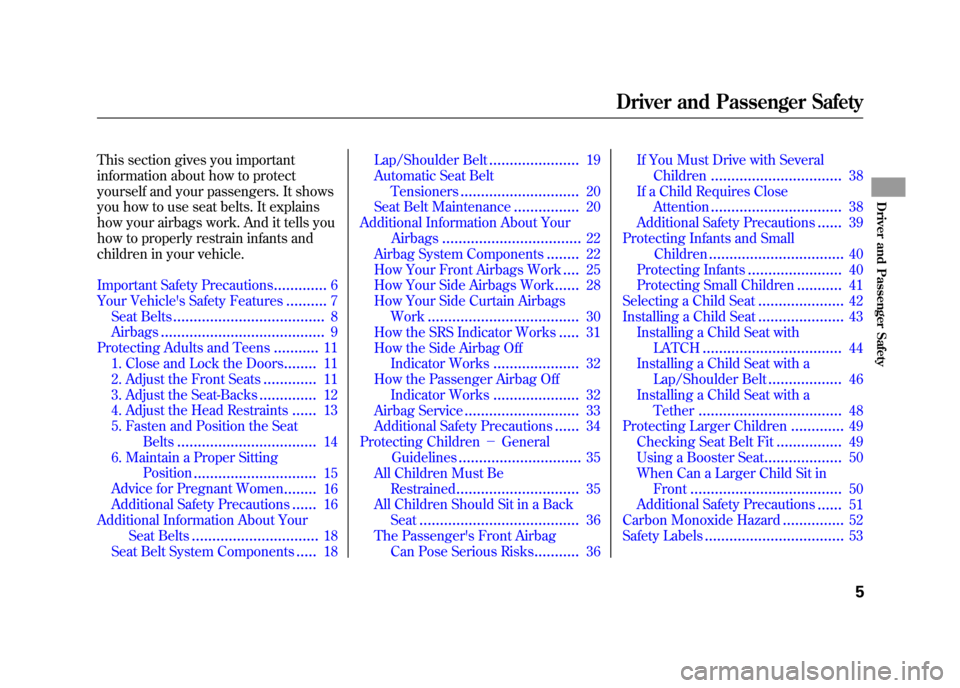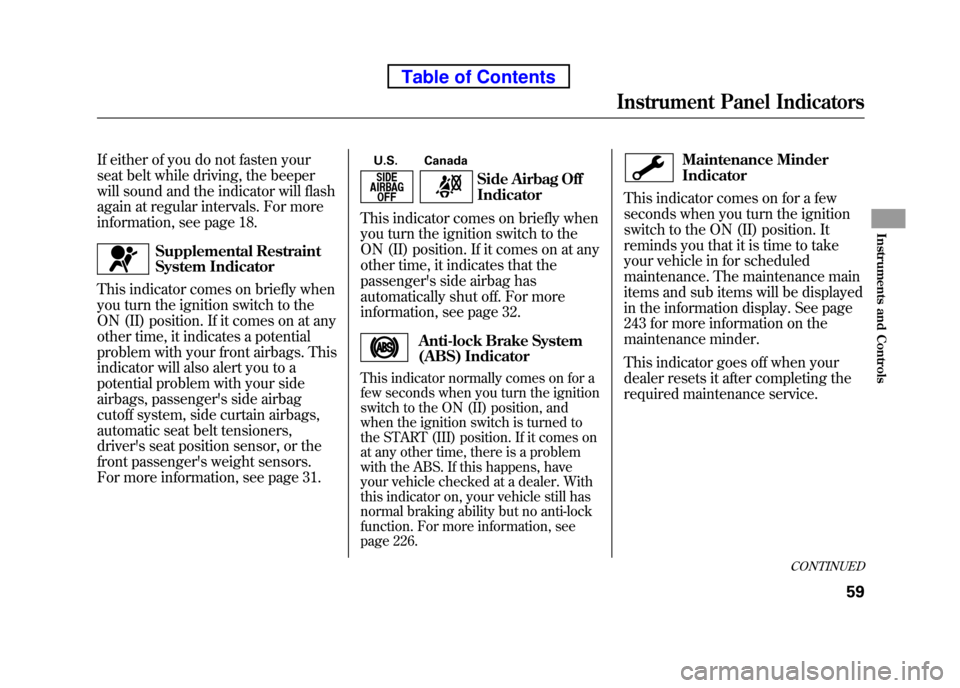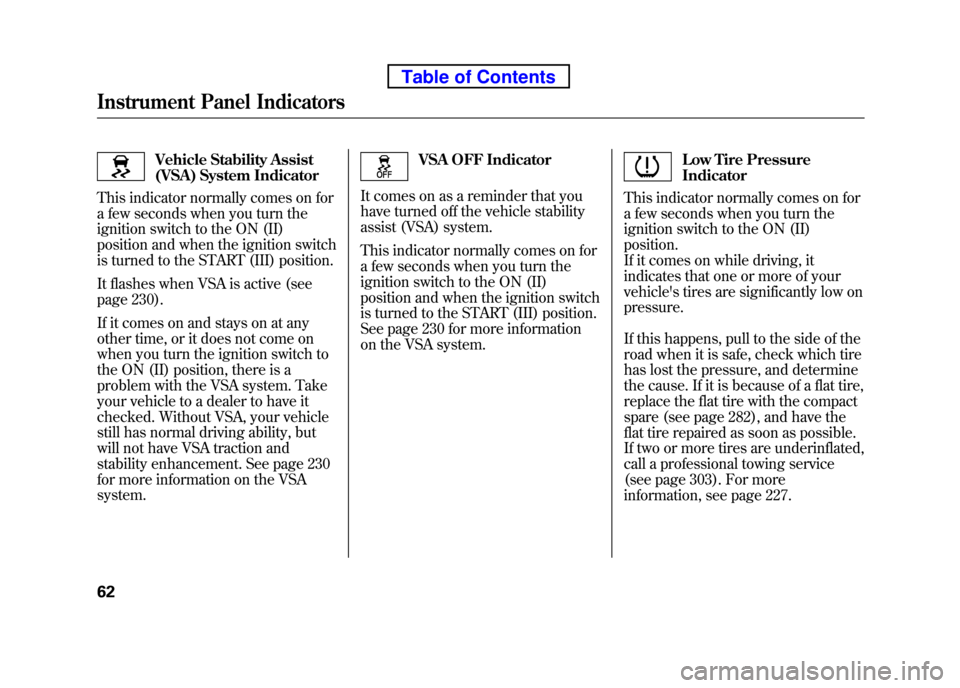service indicator HONDA ELEMENT 2010 1.G Owners Manual
[x] Cancel search | Manufacturer: HONDA, Model Year: 2010, Model line: ELEMENT, Model: HONDA ELEMENT 2010 1.GPages: 342, PDF Size: 5.76 MB
Page 3 of 342

Cup Holders................................. 99
Customer Service .......................322
D
DANGER, Explanation of .............iii
Dashboard ............................... 3, 56
Daytime Running Lights ..............72
Daytime Running Lights
Indicator ................................... 60
Dead Battery .............................. 291
Defects, Reporting Safety (U.S. only) ....................................... 324
Defogger, Rear Window ...............74
Dimensions ................................ 308
Dimming the Headlights ..............71
Dipstick Automatic Transmission .........256
Engine Oil ............................... 201
Directional Signals .................60, 71
Disc Brake Wear Indicators .......225
Disc Care ................................... 183
Disc Changer Error
Messages ............................... 126Disc Player Error
Messages ........................ 125, 148
Disposal of Used Oil ...................253
Doors
Indicator ................................... 11
Locking and Unlocking ............80
Power Door Locks ...................80
DOT Tire Quality Grading (U.S. Vehicles) ................................ 311
Downshifting, Manual Transmission .......................... 217
Driver and Passenger Safety ..........5
Driving ....................................... 213
Economy ................................. 202
Driving Guidelines .....................214
Dust and Pollen Filter ................269
E
Economy, Fuel ........................... 202
Emergencies on the Road ..........281
Battery, Jump Starting .............291
Brake System Indicator .....58, 297
Changing a Flat Tire ...............283Charging System
Indicator ........................ 58, 295
Checking the Fuses ................298
Driving with a Flat Tire ...........282
Hazard Warning Flashers ........73
Jump Starting .......................... 291
Low Oil Pressure
Indicator ........................ 58, 295
Malfunction Indicator Lamp ............................. 58, 296
Overheated Engine .................293
Towing .................................... 303
Emergency Brake ........................94
Emergency Flashers ....................73
Emergency Towing ....................303
Emissions Controls ....................316
Emissions Testing ......................319
CONTINUED
Index
III
INDEX
Page 9 of 342

Wearing a Lap/ShoulderBelt .................................. 14, 19
Seats ............................................ 83
Head Restraints ........................85
Seats, Adjusting the .....................83
Sensors Driver's Seat Position Sensor ...27
Front Passenger's Weight Sensors ................................ 27
Impact Sensors ...................22, 23
Serial Number ............................ 306
Service Intervals .........................243
Service Manual (U.S. only) ........325
Service Station Procedures ........199
Setting the Clock ........................189
Shifting the Automatic Transmission .......................... 219
Shift Lever Position Indicators ...219
Shift Lock Release ......................221
Side Airbags ................................. 28
How the Side Airbag Off
Indicator Works ...................32
How Your Side Airbags Work ..28
Side Curtain Airbags ....................30
How Your Side Curtain Airbags Work .................................... 30Side Marker Lights, Bulb
Replacement in .......................265
Signaling Turns ............................ 60
Snow Tires ................................. 275
Sound System ............................ 109
Spare Tire .................................. 282
Inflating ........................... 271, 282
Specifications .......................... 310
Spark Plugs ................................ 308
Specifications ............................. 308
Speed Control ............................ 193
Speed Limiter ......................218, 221
Speedometer ................................ 64
SRS, Additional Information .........22
Additional Safety Precautions ...34
Airbag Service .......................... 33
Airbag System Components .....22
How the Side Airbag Off Indicator Works ...................32
How the SRS Indicator Works ..31
How Your Front Airbags
Work .................................... 25
How Your Side Airbags Work ..28
How Your Side Curtain Airbags Work .................................... 30
SRS Indicator ......................... 31, 59START (Ignition Key Position)
.....79
Starting the Engine ....................216
In Cold Weather at High Altitude ................................ 216
With a Dead Battery ................291
State Emissions Testing .............319
Steam Coming from Engine .......293
Steering Wheel Adjustment ............................... 74
Anti-theft Column Lock ............79
Buttons ........................... 191, 193
Stereo Sound System .................109
Storing Your Vehicle ..................278
Sun Visor ................................... 100
Supplemental Restraint
System .............................. 9, 22
Servicing .................................. 33
SRS Indicator ...................... 31, 59
System Components ................22
Synthetic Oil .............................. 252
T
Tachometer .................................. 64
CONTINUED
Index
IX
INDEX
Page 17 of 342

Your Vehicle at a Glance(main controls).................................................................................................................... 3
Driver and Passenger Safety (seat belts, SRS, and child protection) ........................................................................... 5
Instruments and Controls (indicators, gauges, dashboard, and steering column) ....................................................55
Features (heating and cooling, audio, steering wheel, cruise control, and other convenience items) ......................103
Before Driving (fuel, vehicle break-in, and cargo loading) ....................................................................................... 197
Driving (engine and transmission operation) ........................................................................................................... 213
Maintenance (minder, fluid checking, minor services, and vehicle storage) ...........................................................241
Taking Care of the Unexpected (flat tire, jump starting, overheating, and fuses) ...................................................281
Technical Information (vehicle specifications, tires, and emissions controls) ........................................................305
Warranty and Customer Relations (U.S. and Canada only) (warranty and contact information)........................321
Index .............................................................................................................................................................................. I
INDEX
Service Information Summary(fluid capacities and tire pressures) ............................................................... last page
Contents
1
Page 18 of 342

Contents
A convenient reference to the
sections in this manual.
Your Vehicle at a Glance
A quick reference to the main
controls in your vehicle.
Driver and Passenger Safety
Important information about the
proper use and care of your vehicle's
seat belts, an overview of the
supplemental restraint system, and
valuable information on how to
protect children with child restraints.
Instruments and Controls
Explains the purpose of each
instrument panel indicator and
gauge, and how to use the controls
on the dashboard and steeringcolumn. Features
How to operate the heating and air
conditioning system, the audio
system, and other conveniencefeatures.Before Driving
What gasoline to use, how to break-
in your new vehicle, and how to load
luggage and other cargo. Driving
The proper way to start the engine,
shift the transmission, and park; plus
what you need to know if you're
planning to tow a trailer. Maintenance
The maintenance minder shows you
when you need to take your vehicle
to the dealer for maintenance
service. There is also a list of things
to check and instructions on how to
check them.
Taking Care of the Unexpected
This section covers several problems
motorists sometimes experience, and
details how to handle them.
Technical Information
ID numbers, dimensions, capacities,
and technical information.
Warranty and Customer Relations
(U.S. and Canada only)
A summary of the warranties
covering your new vehicle, and how
to contact us for any reason. Refer to
your warranty manual for detailedinformation. Index
Service Information Summary
A summary of the information you
need when you pull up to the fuelpump.
Overview of Contents
2
Page 21 of 342

This section gives you important
information about how to protect
yourself and your passengers. It shows
you how to use seat belts. It explains
how your airbags work. And it tells you
how to properly restrain infants and
children in your vehicle.
Important Safety Precautions.............6
Your Vehicle's Safety Features ..........7
Seat Belts ..................................... 8
Airbags ........................................ 9
Protecting Adults and Teens ...........11
1. Close and Lock the Doors ........11
2. Adjust the Front Seats .............11
3. Adjust the Seat-Backs ..............12
4. Adjust the Head Restraints ......13
5. Fasten and Position the Seat Belts .................................. 14
6. Maintain a Proper Sitting Position .............................. 15
Advice for Pregnant Women ........16
Additional Safety Precautions ......16
Additional Information About Your Seat Belts ............................... 18
Seat Belt System Components .....18 Lap/Shoulder Belt
......................19
Automatic Seat Belt Tensioners ............................. 20
Seat Belt Maintenance ................20
Additional Information About Your Airbags .................................. 22
Airbag System Components ........22
How Your Front Airbags Work ....25
How Your Side Airbags Work ......28
How Your Side Curtain Airbags Work ..................................... 30
How the SRS Indicator Works .....31
How the Side Airbag Off Indicator Works .....................32
How the Passenger Airbag Off Indicator Works .....................32
Airbag Service ............................ 33
Additional Safety Precautions ......34
Protecting Children -General
Guidelines .............................. 35
All Children Must Be
Restrained .............................. 35
All Children Should Sit in a Back Seat ....................................... 36
The Passenger's Front Airbag
Can Pose Serious Risks ...........36If You Must Drive with Several
Children ................................ 38
If a Child Requires Close Attention ................................ 38
Additional Safety Precautions ......39
Protecting Infants and Small Children ................................. 40
Protecting Infants .......................40
Protecting Small Children ...........41
Selecting a Child Seat .....................42
Installing a Child Seat .....................43
Installing a Child Seat with
LATCH .................................. 44
Installing a Child Seat with a Lap/Shoulder Belt ..................46
Installing a Child Seat with a
Tether ................................... 48
Protecting Larger Children .............49
Checking Seat Belt Fit ................49
Using a Booster Seat ...................50
When Can a Larger Child Sit in
Front ..................................... 50
Additional Safety Precautions ......51
Carbon Monoxide Hazard ...............52
Safety Labels .................................. 53
Driver and Passenger Safety
5
Driver and Passenger Safety
Page 49 of 342

If the indicator comes on with no
front seat passenger and no objects
on the seat, or with an adult riding
there, something may be interfering
with the weight sensors. Look for
and remove:● Any items under the front
passenger's seat.
● Any object(s) hanging on the seat
or in the seat-back pocket.
● Any object(s) touching the rear of
the seat-back.
If no obstructions are found, have
your vehicle checked by a dealer as
soon as possible. Airbag Service
Your airbag systems are virtually
maintenance free, and there are no
parts you can safely service.
However, you must have your
vehicle serviced if:
●
An airbag ever inflates.Any airbag
that has deployed must be
replaced along with the control
unit and other related parts. Any
seat belt tensioner that activates
must also be replaced.
Do not try to remove or replace
any airbag by yourself. This must
be done by an authorized dealer or
a knowledgeable body shop.
●
The SRS indicator alerts you to a problem.
Take your vehicle to an
authorized dealer as soon as
possible. If you ignore this
indication, your airbags may not
operate properly. ●
If your vehicle has a moderate to
severe impact.
Even if your airbags
do not inflate, your dealer should
inspect the driver's seat position
sensor, the front passenger's
weight sensors, the front seat belt
tensioners, and all seat belts and
their anchors worn during a crash
to make sure they are operating properly.
Additional Information About Your Airbags
33
Driver and Passenger Safety
Table of Contents
Page 75 of 342

If either of you do not fasten your
seat belt while driving, the beeper
will sound and the indicator will flash
again at regular intervals. For more
information, see page 18.
Supplemental Restraint
System Indicator
This indicator comes on briefly when
you turn the ignition switch to the
ON (II) position. If it comes on at any
other time, it indicates a potential
problem with your front airbags. This
indicator will also alert you to a
potential problem with your side
airbags, passenger's side airbag
cutoff system, side curtain airbags,
automatic seat belt tensioners,
driver's seat position sensor, or the
front passenger's weight sensors.
For more information, see page 31. U.S. Canada
Side Airbag Off Indicator
This indicator comes on briefly when
you turn the ignition switch to the
ON (II) position. If it comes on at any
other time, it indicates that the
passenger's side airbag has
automatically shut off. For more
information, see page 32.
Anti-lock Brake System
(ABS) Indicator
This indicator normally comes on for a
few seconds when you turn the ignition
switch to the ON (II) position, and
when the ignition switch is turned to
the START (III) position. If it comes on
at any other time, there is a problem
with the ABS. If this happens, have
your vehicle checked at a dealer. With
this indicator on, your vehicle still has
normal braking ability but no anti-lock
function. For more information, see
page 226.
Maintenance Minder Indicator
This indicator comes on for a few
seconds when you turn the ignition
switch to the ON (II) position. It
reminds you that it is time to take
your vehicle in for scheduled
maintenance. The maintenance main
items and sub items will be displayed
in the information display. See page
243 for more information on the
maintenance minder.
This indicator goes off when your
dealer resets it after completing the
required maintenance service.
CONTINUED
Instrument Panel Indicators
59
Instruments and Controls
Table of Contents
Page 78 of 342

Vehicle Stability Assist
(VSA) System Indicator
This indicator normally comes on for
a few seconds when you turn the
ignition switch to the ON (II)
position and when the ignition switch
is turned to the START (III) position.
It flashes when VSA is active (see
page 230).
If it comes on and stays on at any
other time, or it does not come on
when you turn the ignition switch to
the ON (II) position, there is a
problem with the VSA system. Take
your vehicle to a dealer to have it
checked. Without VSA, your vehicle
still has normal driving ability, but
will not have VSA traction and
stability enhancement. See page 230
for more information on the VSAsystem.VSA OFF Indicator
It comes on as a reminder that you
have turned off the vehicle stability
assist (VSA) system.
This indicator normally comes on for
a few seconds when you turn the
ignition switch to the ON (II)
position and when the ignition switch
is turned to the START (III) position.
See page 230 for more information
on the VSA system.Low Tire Pressure Indicator
This indicator normally comes on for
a few seconds when you turn the
ignition switch to the ON (II)position.
If it comes on while driving, it
indicates that one or more of your
vehicle's tires are significantly low onpressure.
If this happens, pull to the side of the
road when it is safe, check which tire
has lost the pressure, and determine
the cause. If it is because of a flat tire,
replace the flat tire with the compact
spare (see page 282), and have the
flat tire repaired as soon as possible.
If two or more tires are underinflated,
call a professional towing service
(see page 303). For more
information, see page 227.
Instrument Panel Indicators
62
Table of Contents
Page 83 of 342

If the system still detects a leak in
your vehicle's evaporative emissions
system, the malfunction indicator
lamp (MIL) comes on. If the fuel fill
cap was not already tightened, turn
the engine off, and check or
retighten the fuel fill cap until it
clicks at least once. The MIL should
go off after several days of normal
driving once the cap is tightened or
replaced. If the MIL does not go off,
have your vehicle inspected by a
dealer. For more information, see
page 296.Temperature Gauge
This shows the temperature of the
engine's coolant. During normal
operation, the pointer should rise to
about the middle of the gauge. In
severe driving conditions, the pointer
may rise to the upper zone. If it
reaches the red (hot) mark, pull
safely to the side of the road. Turn to
page 293 for instructions and
precautions on checking the engine's
cooling system.
Maintenance Minder
The information display in the
instrument panel shows you the
engine oil life and maintenance
service items when the ignition
switch is in the ON (II) position. This
information helps to keep you aware
of the periodic maintenance your
vehicle needs for continued trouble-
free driving. Refer to page 243 for
more information.
Gauges
67
Instruments and Controls
Table of Contents
Page 214 of 342

Break-in Period
Help assure your vehicle's future
reliability and performance by paying
extra attention to how you drive
during the first 600 miles (1,000 km).
During this period:● Avoid full-throttle starts and rapidacceleration.
● Do not change the oil until the
scheduled maintenance time.
● Avoid hard braking for the first 200
miles (300 km).
● Do not tow a trailer.
You should also follow these
recommendations with an
overhauled or exchanged engine, or
when the brakes are replaced. Fuel Recommendation
Your vehicle is designed to operate
on unleaded gasoline with a pump
octane number of 87 or higher. Use
of a lower octane gasoline can cause
a persistent, heavy metallic rapping
noise that can lead to enginedamage.
On vehicles with manual transmission
You may hear a knocking noise from
the engine if you drive the vehicle at
low engine speed (below about 1,000
rpm) in a higher gear. To stop this,
raise the engine speed by shifting to
a lower gear.
We recommend using quality
gasoline containing detergent
additives that help prevent fuel
system and engine deposits.In addition, in order to maintain good
performance, fuel economy, and
emissions control, we strongly
recommend, in areas where it is
available, the use of gasoline that
does NOT contain manganese-based
fuel additives such as MMT.
Use of gasoline with these additives
may adversely affect performance,
and cause the malfunction indicator
lamp on your instrument panel to
come on. If this happens, contact
your authorized dealer for service.
Some gasoline today is blended with
oxygenates such as ethanol or
MTBE. Your vehicle is designed to
operate on oxygenated gasoline
containing up to 10% ethanol by
volume and up to 15% MTBE by
volume. Do not use gasoline
containing methanol.
Break-in Period, Fuel Recommendation
198
Table of Contents